Universal Tithing
We Should Tithe More! (and where I’m personally giving 20% of my income)
Hi! The goal of this article is to show:
- Why “universal tithing” is a key leverage point for a global paradigm shift.
- The charities I tithe to.
tl;dr
- I donate (tithe) 20% of my post-tax income to charity (and feel great!). I make $70,000/year (post-tax $52,000/year, $4,400/month), so donate $880/month to charity.
- If you’re just starting to tithe, at a bare minimum I recommend the “$50/month package”. With it, you can:
- Donate $30/month to GiveDirectly to support a basic income for someone in extreme poverty in Kenya.
- Donate $10/month to Coalition for Rainforest Nations to offset your annual carbon emissions. (That’s 1 month to offset 1 year! So if you do this for 12 months, you’ll have offset 12 years of your life!)
- Still have $10/month leftover to donate to a (perhaps local?) organization that deeply matters to you.
- Personally experience your mindset change towards abundance!
Let’s begin!
Why “Universal Tithing” Has Powerful Global Emergent Properties
We’re all exploring the idea maze around the question—“How can I have a large positive impact on the world?” After exploring the maze for the past year and a half, I’m strongly in favor of “Universal Tithing”—a “global tax” where everyone gives a percentage of their income to charity/civil society. I think it has powerful emergent properties (and should be prioritized more).
But why? I like to think from the perspective of playing a game. When you begin to play a game, you:
- Understand the goal of the game
- Understand the rules of the game
- Understand the context of the game
- Test strategies given that goal+rule+context set.
Universal Tithing is a strategy given how I understand the goal+rules+context of the game. For our current technosocietal context, here is how I see the game:
Goal: Maximize humanity’s cosmic endowment—try to make as many people “happy”, including those in the future.
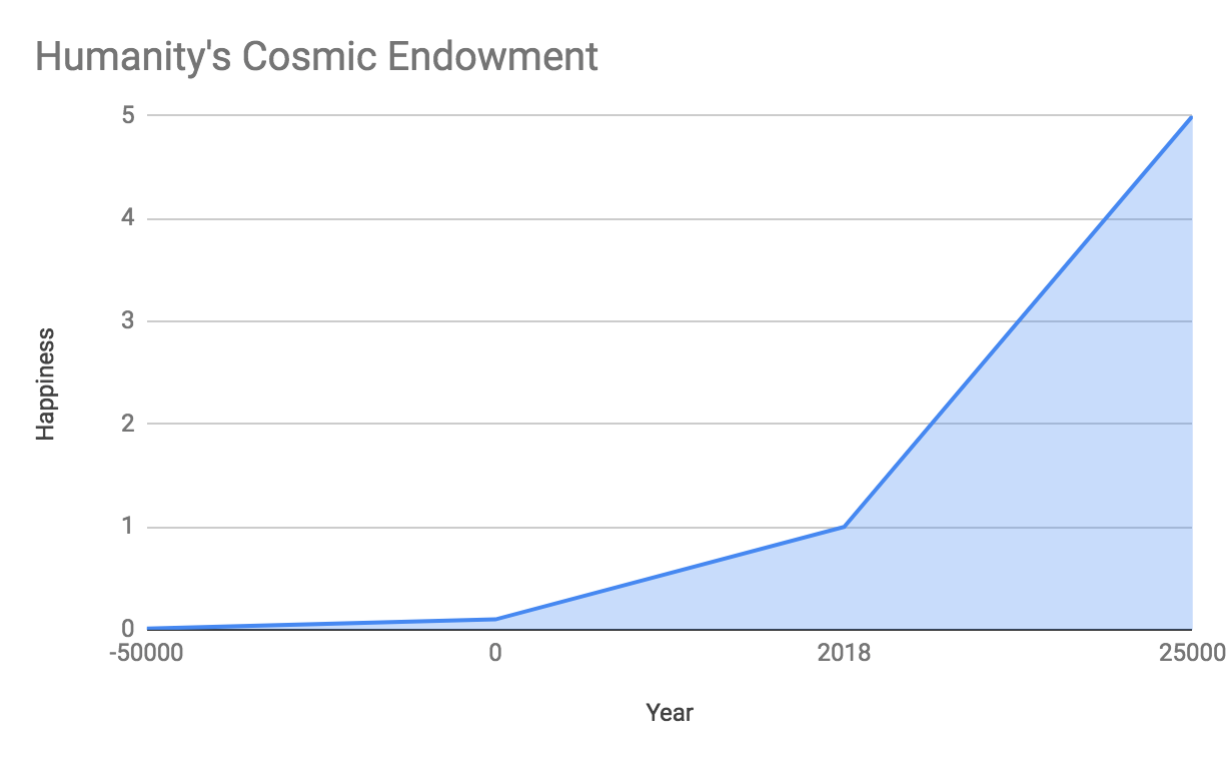
Rules: Aside from physical laws, I think the most helpful way to understand the rules of the game is through systems thinking. More specifically, Value Paradigms (in the Donella Meadows’ sense) are the place of highest leveragewithin a system. You can imagine them as one level above Lessig’s pathetic dot. (i.e. Value Paradigms are manifest through markets, architecture, laws, and norms.)
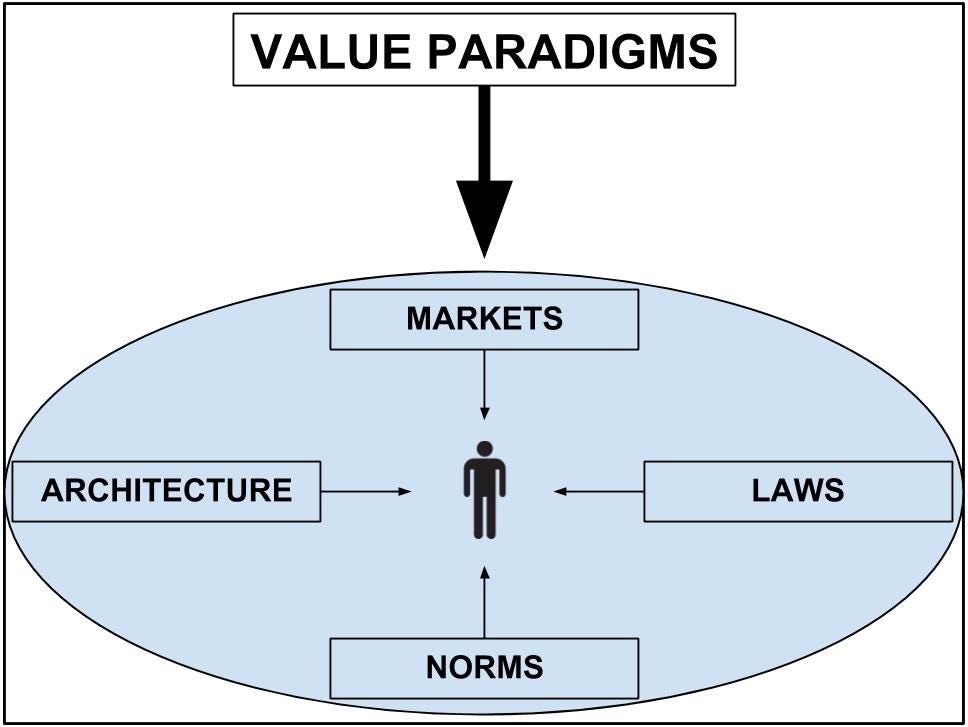
Context: This answers the question—where are we in time? i.e. What is our current global situation, in 2019? We exist in Abundant Fragility. (Things are so much better than 200 years ago and our exponential curves may deeply hurt us.)
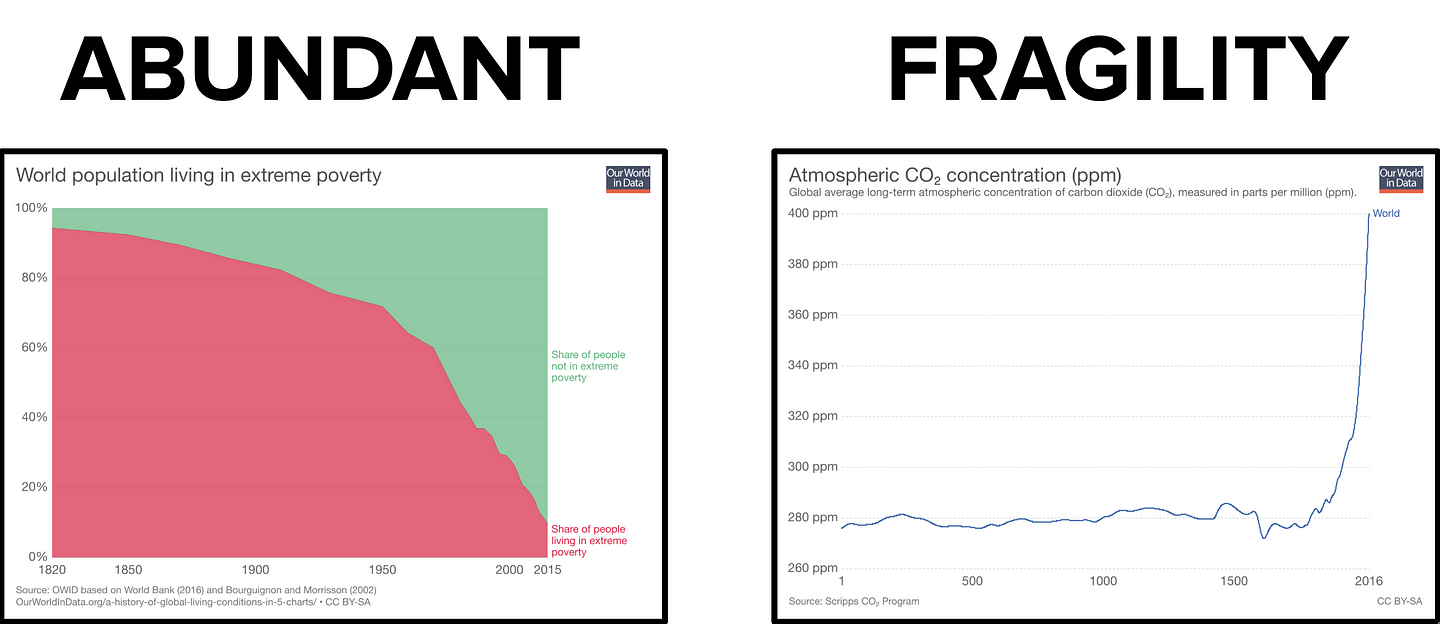
Strategies: There are a variety of strategies that folks are attempting to deploy (both at the Value Paradigm level and at the Lessig Dot level). I’m proposing Universal Tithing as a high-impact strategy.
To conclude this in one sentence, I’d say:
Given our macro goal of Maximizing Humanity’s Cosmic Endowment, our 2019 context of Abundant Fragility, and the leverage of Value Paradigms to change systems…I propose Universal Tithing as a high-impact strategy.
What is Universal Tithing?
Universal Tithing is the idea that (essentially) everyone should give a percentage of their income/wealth to charity. I like to think of it as a variant on taxes. Taxes are a process instituted by nation-states where the government decides how much you give and to whom. Nation-states enforce taxes through law (if you don’t pay your taxes you go to jail). On the other hand, Universal Tithing is a giving process instituted by individuals, enforced by social Norms rather than Law. In short:
- Taxes are determined by the state and enforced by law
- Universal Tithing is determined by individuals and enforced by norms
Another way to think about Universal Tithing is “what does the money fund?”
- Profits fund Corporations
- Taxes fund Government
- Tithing funds Civil Society
A final way to think of Universal Tithing is: “Of all the money I make/take as input, how much of it goes to Self vs. is Taxed vs. is Tithed?” For example, I make $5,834/month. Of that, 25% ($1,456) is Taxed and 15% (20% post-tax, $876) is Tithed.
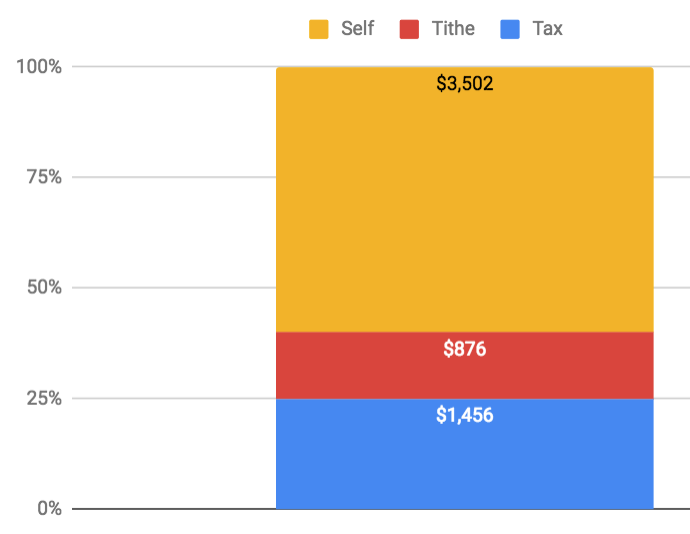
There are a couple proto-examples of Universal Tithing (UT) in the world. Most of them come from the Effective Altruist movement, where folks pledge a percentage of their income to charity (FoundersPledge, Giving What We Can Pledge, TLYCS Pledge). e.g. GWWC’s mission is “A world in which giving 10% of our income to the most effective organizations is the norm.” But there are also non-EA organizations like The Awesome Foundation (which has a bunch of city chapters that give out $1,000 grants each month).
Why Is Universal Tithing an Optimal Strategy Right Now?
UT is an optimal strategy right now for two reasons:
- It creates a powerful positive feedback loop that is enables long-term human flourishing.
- By giving to create that positive feedback loop, we create a Value Paradigm shift from a scarcity-driven world to an abundance-driven world. i.e. By individuals deciding to give (mostly of their own volition!), they “self-fulfilling prophecy” (yes, as a verb) themselves into an abundant mindset (by giving, they think they have “enough” to give!).
Creating a Positive Feedback Loop for Long-Term Human Flourishing
Let’s look at the 1st point—that UT creates a new positive feedback loop. I like to think of this loop as “Stage 2” of a Positive Sum world. Let’s contrast it with Stage 1—“Buyer-Seller Positive Sum Capitalism”. This is what they call the Double Thank-You of Capitalism, “the observation that, when a merchant and a customer exchange money for goods, each thanks the other, showing that the transaction is not only voluntary, but mutually beneficial.” This occurs at the micro level (buyer-seller) and at the macro level (global trade with importer-exporter). Nassim Nicholas Taleb also expresses a similar idea in Antifragile: “Perhaps the idea behind capitalism is…: the system facilitates the conversion of selfish aims (or, to be correct, not necessarily benevolent ones) at the individual level into beneficial results for the collective.” It’s tough to remind ourselves of this, but Stage 1 Buyer-Seller Positive Sum Capitalism is a relatively recent addition to humanity (starting with initial trade, then money-facilitated trade, then an Industrial Revolution + Globalization-fueled world market).
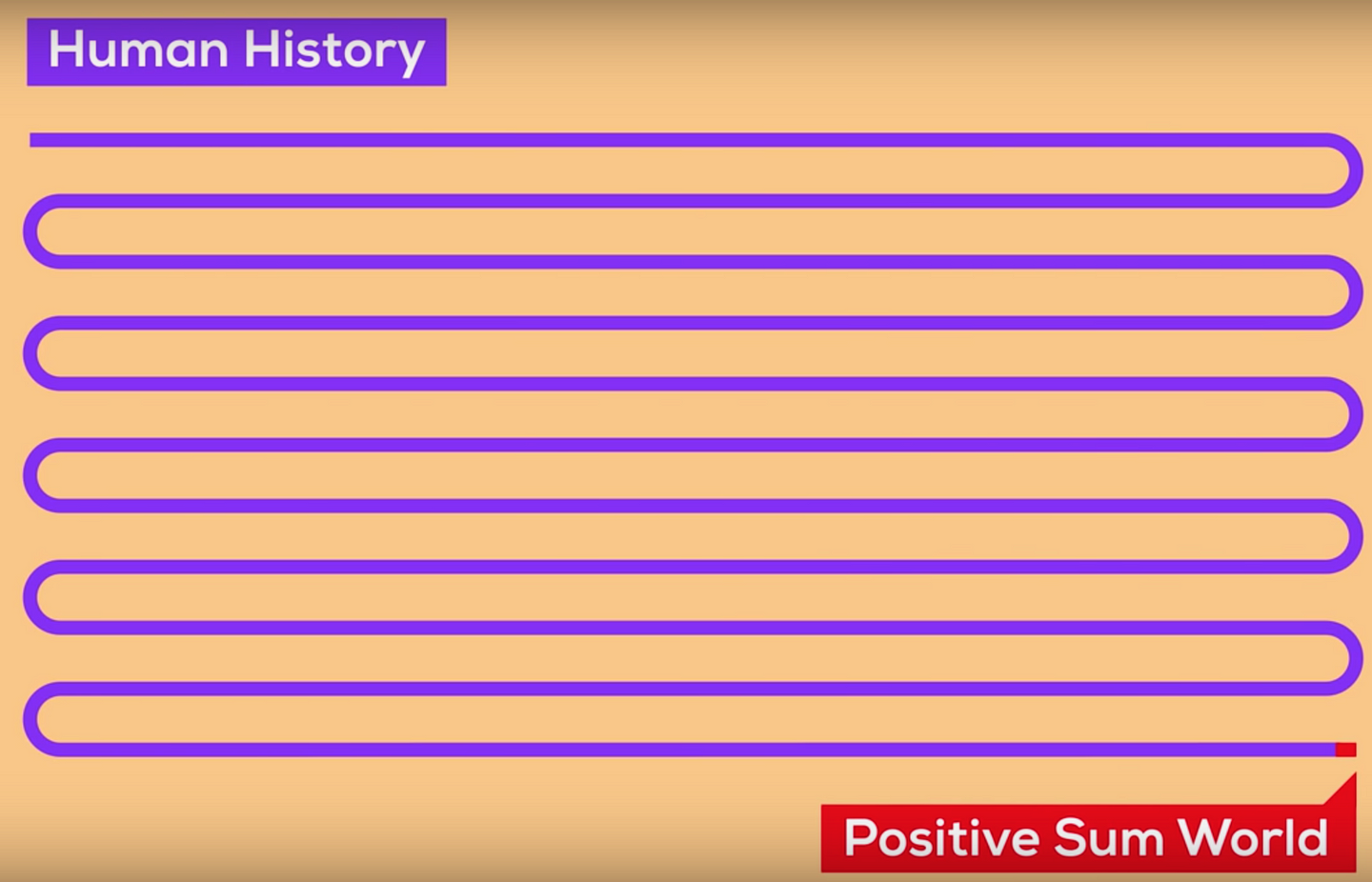
I think of Universal Tithing as a “Stage 2” Positive Sum Game because its mechanics are categorically different from the buyer-seller mechanics in capitalism (and Stage 1 Positive Sum Games). At a high level, here’s the idea:
- Rich folks have enough money.
2. We can give our extra money to poor folks to release them from their scarcity mindset and help us solve long-term problems.
I like to think of it as an overflowing series of cups, where, once one has “enough”, they can tithe to support others in civil society.
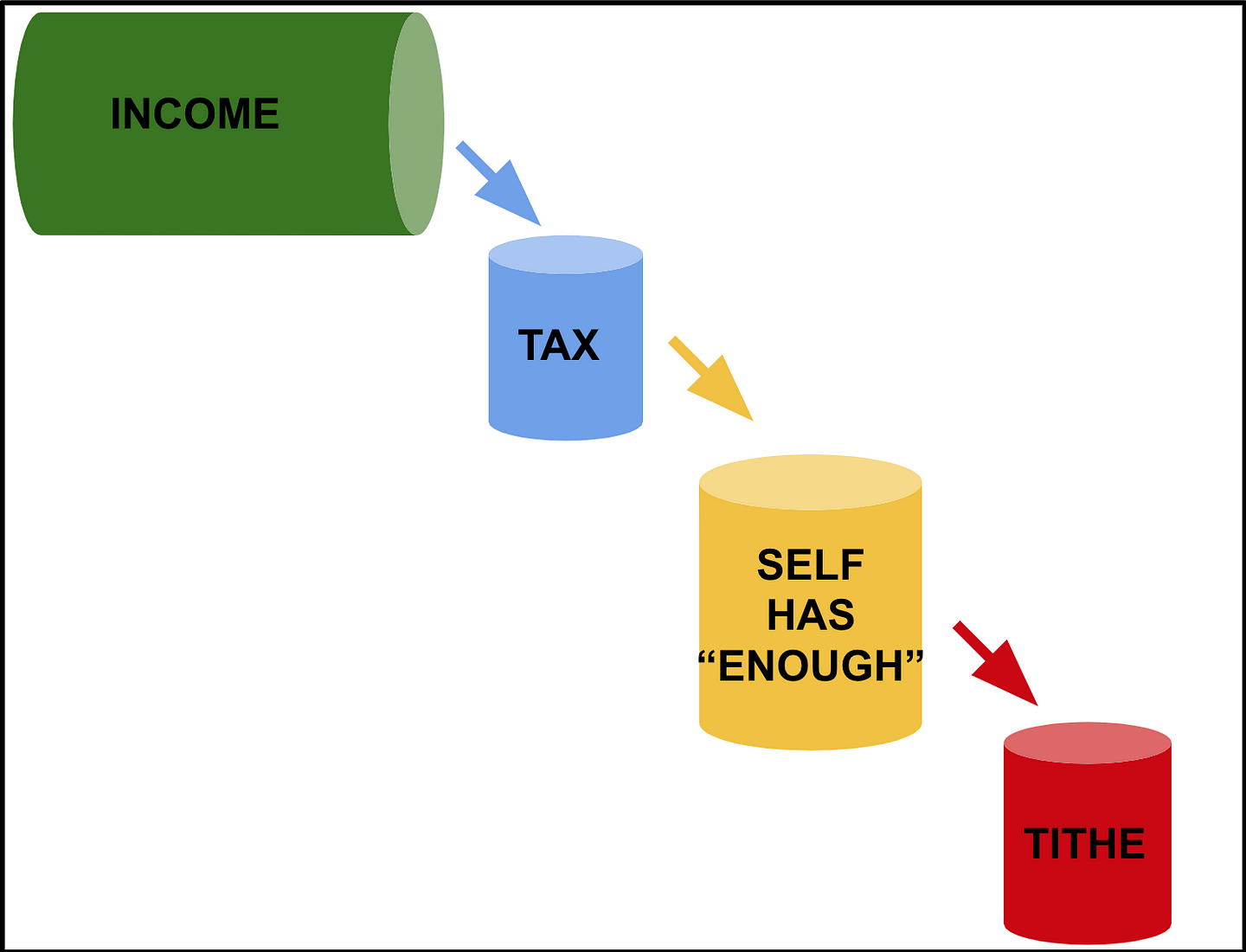
Let’s look a bit deeper at the idea that “We Have Enough” through the lens of global income. In Factfulness, Hans Rosling breaks down the global population into 4 levels based on income. The one billion people on Level 1 make $0–$2/day. The three billion people on Level 2 make $2–$8/day. The two billion people on Level 3 make $8–$32/day. And the one billion people on Level 4 make more than $32/day. This is all expressed in the simple picture below:

True “enoughness” though is expressed by saying that those who make over $120/day (~$44,000/year) don’t get measurably happier when they make more money. We can think of the folks who have passed this point as existing on “Level 5: Abundance”. (Or Level 5: Enough.)
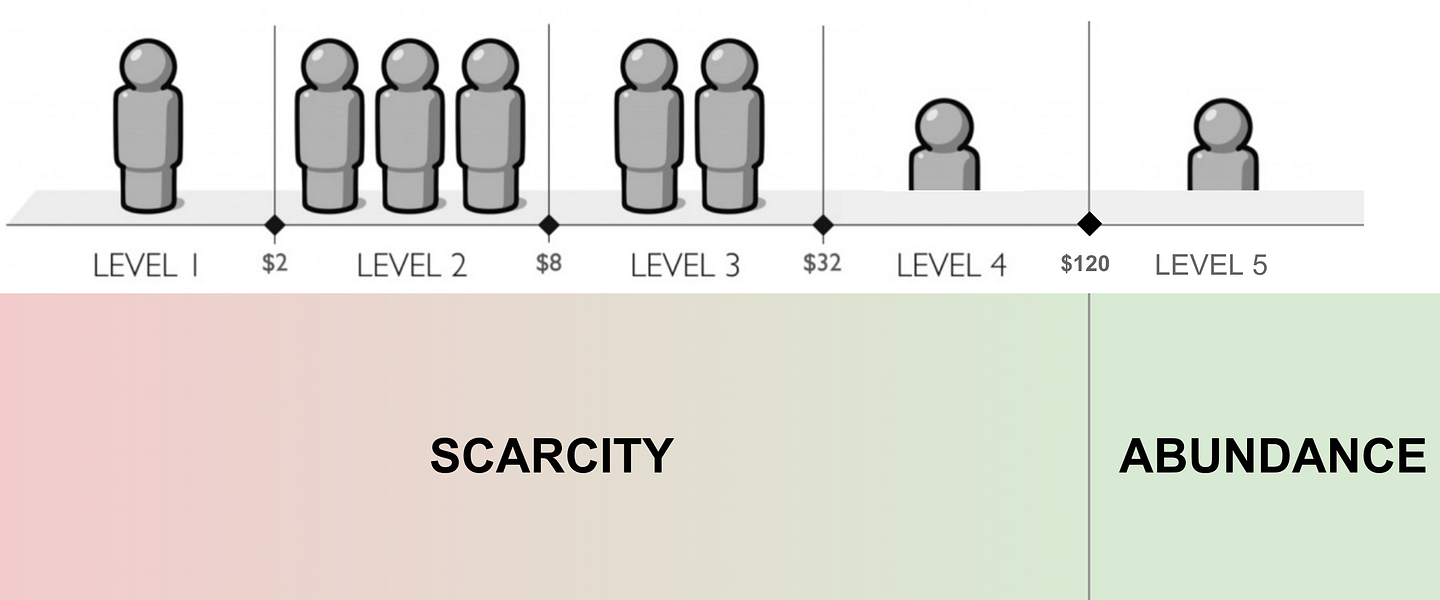
This “enoughness” means that you’ve essentially “reached the limit” of Stage 1 Buyer-Seller Positive Sum Games. i.e. You can’t buy/consume/accumulate much more that would actually increase your happiness.
This “extra money” allows you to begin to play the 2nd game: to help poor folks “level up” so they can help you solve more long-term problems. This is the idea that “The more people that want the same thing you want, the more likely you are to get it.” Giving to Level 1 folks would make me happier because it helps them be more like me (Level 5), increasing the supply and demand for things I want. (If you want to learn more about this, I highly recommend this quick 7min video from Kurzgesagt.)
Here’s a graph of what that looks like on a world scale. Each stick figure represents 1B people. Green represents Level 4 folks and red represents Level 1–3 folks.
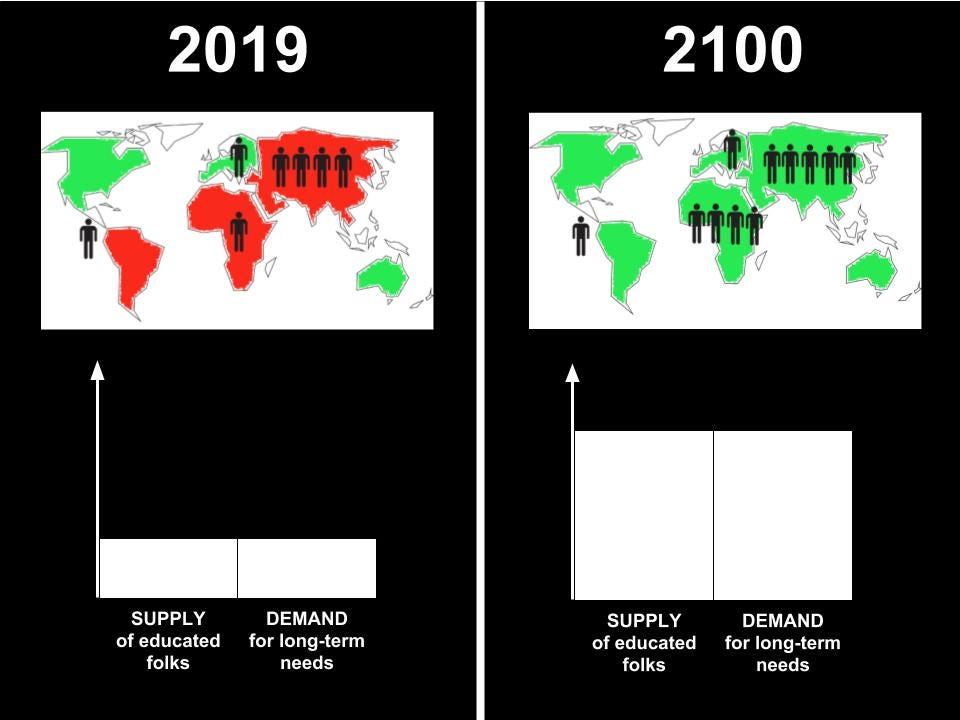
Although this graph is relatively general (it only looks at the continents, billions of people, and two kinds of income buckets), I think it tells a crucial story. Right now, in 2019, we don’t have many Level 4 folks (and they primarily live in Europe and North America), while we have billions of people at Level 1–3 in Africa, Asia, and South America. In this scenario we don’t have great dynamics for “long-term alignment on needs” because there aren’t that many Level 4 folks! (So there are a bunch of Level 1–3 folks who we’d love to help us with stopping climate change, curing cancer, etc., but they’re stuck worrying about their basic needs.)
The hope is that by 2100, we’ll have Level 4 (and Level 5) folks almost everywhere. Imagine a world with almost all educated folks who are aligned around the long-term future of humanity. In other words, we hope the “income levels over time” graph looks something like this:

If many Level 4s and 5s actually give, this kind of “mass giving” would be a drastic departure from our current day. Right now, most developed countries donate less than 1% of their GDP to charity (see Graph 27 here). For example, the United States has consistently donated 2% of GDP to charity over the last 50 years:
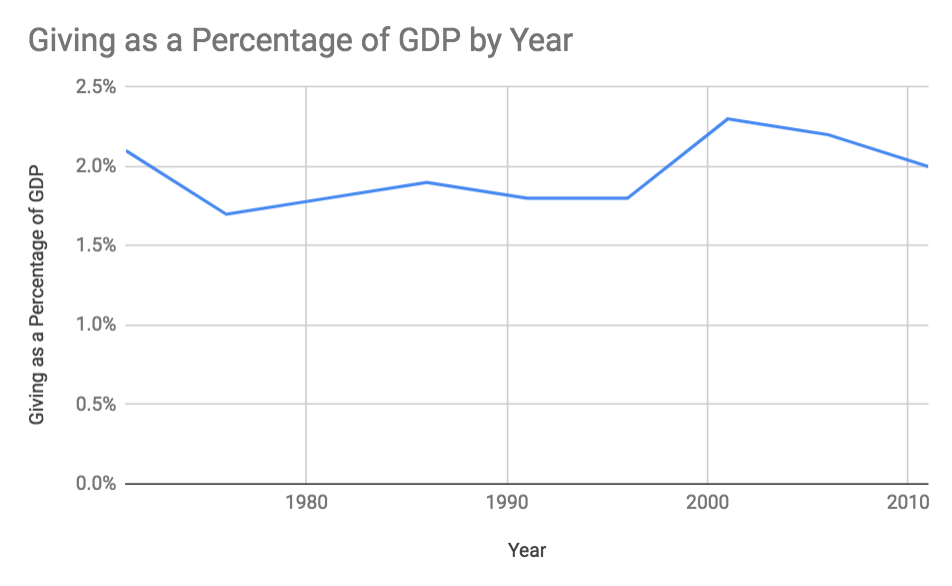
This 2% number has stayed constant even as GDP per capita has risen from $24,400 to $53,000. Wouldn’t you think that, as people get more money (and reach “enoughness”), that they would give a higher percentage of their wealth? Our giving habits haven’t caught up to our level of abundance. The hope is that more Level 5 folks will give, extending the graph above to look something like this as we head towards 2040:
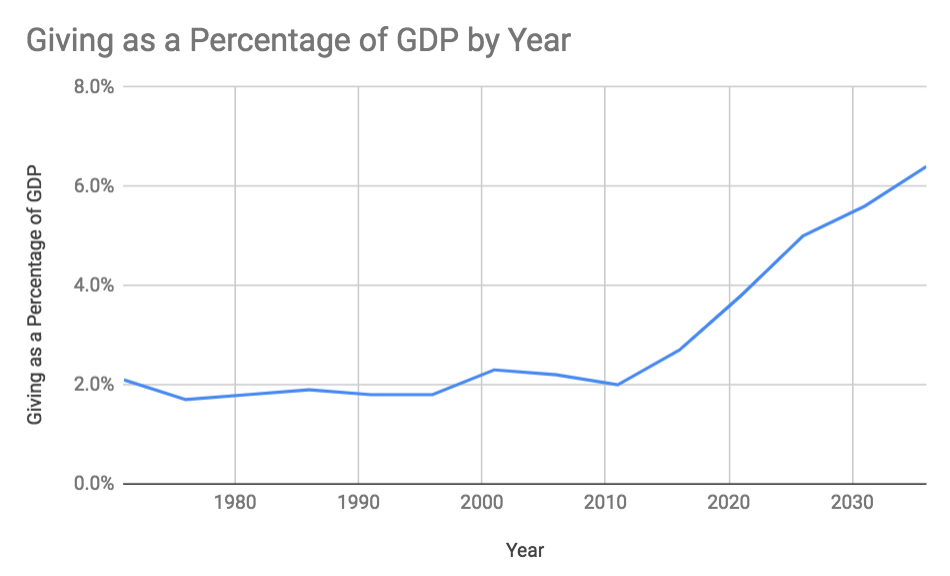
(Or, alternatively, you can think of this in comparison to the federal budget. Right now the U.S. government spends $4T per year and citizens give $400B per year, or 10% of federal spending. Is there a future in which that number is more like 25% or 50%?)
One final way that I like to think of this mechanism is in terms of “return on investment” (ROI). Universal Tithing is a form of “Indirect ROI”, which is different than traditional “Direct ROI”. With Direct ROI, we invest money and get more money in return. Within Indirect ROI, we give money and receive “happiness/meaning” (not financial capital) in return through the supply/demand dynamics described above.
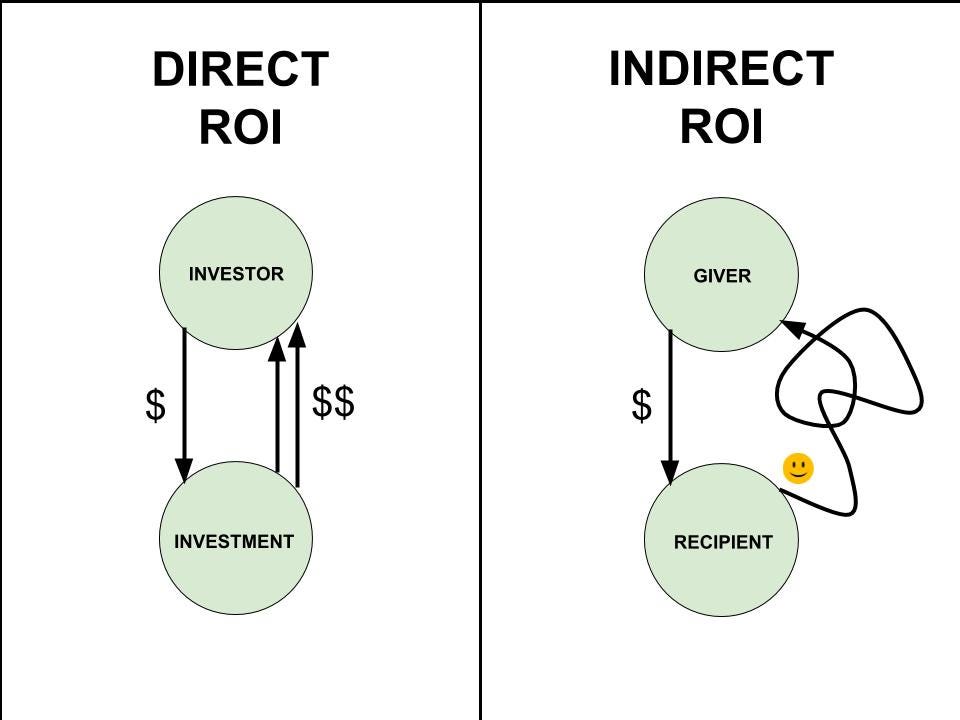
To conclude: now that Level 5’s exist, the best way for them to maximize their happiness is by giving to Level 1’s so they can help us solve humanity’s long-term problems.
Creating a Value Paradigm Shift to an Abundance-Driven World
In addition, the Universal Tithing process also changes our mindset/values/paradigm. i.e. The action of tithing creates a feeling of abundance in our minds. I’m not sure the best way to describe this, and it’s a bit less well-defined for me. However, here are some starting thoughts:
- I like to think about the positive feedback loop described above as the external result of UT. But giving also has an internal change in our individual mindset (which then leads to a global change to the paradigmthat we exist in).
- You can think of this is as a flow-through effect of giving. i.e. By giving, we have a long-term, indirect, and hard to measure effect of changing our own mindset towards abundance. e.g. Universal Tithing could change the value paradigm of individuals and then have that trickle up (through laws) to corporations. (As opposed to, say, changing the rules of the corporation itself, like B Corps.)
- As an example of “abundance begetting abundance”, see this $1000 grantfrom the Awesome Foundation to give $10 to 100 other people (instead of to spend on oneself).
This idea (obviously) has a lot more fleshing out to do. But the crucial nugget is this—creating a culture of giving is as much about the culture as it is about the giving.
(Note: in addition to the points above, Universal Tithing has a couple other systemically positive properties. However, these ideas aren’t crucial, so I’ve extracted them into a sub-article here. The summary of that article: UT acts as a “synergistic satisfier”, forces individual responsibility, solves the abstracted job-to-be-done of civil society + government [public goods], and helps us solve other emergent problems.)
What Did I Give To?
In the 2nd part of this post, I’d like to describe what I gave to. There are no right answers here, but I think it’ll be helpful to see my process. As a reminder, I’m tithing my income $880/month. This is 20% of my post-tax income. I like to think about it like this (all shown in the graph below):
- My income “input” is $70,000 total
- Of that, 25% gets taxed to the government (about 5% to state, 20% to federal)
- Of the remaining 75%, 20% gets tithed to charity (~15% of my pre-tax income).

I think of both the tithe and the tax as similar—they are both money going towards the public good (instead of myself). With the tithe, I make the decision of how much money and where it goes. With the tax, the government makes the decision of how much money and where it goes. Another way to think of this is by looking at the [self, tithed, taxed] graph over time:
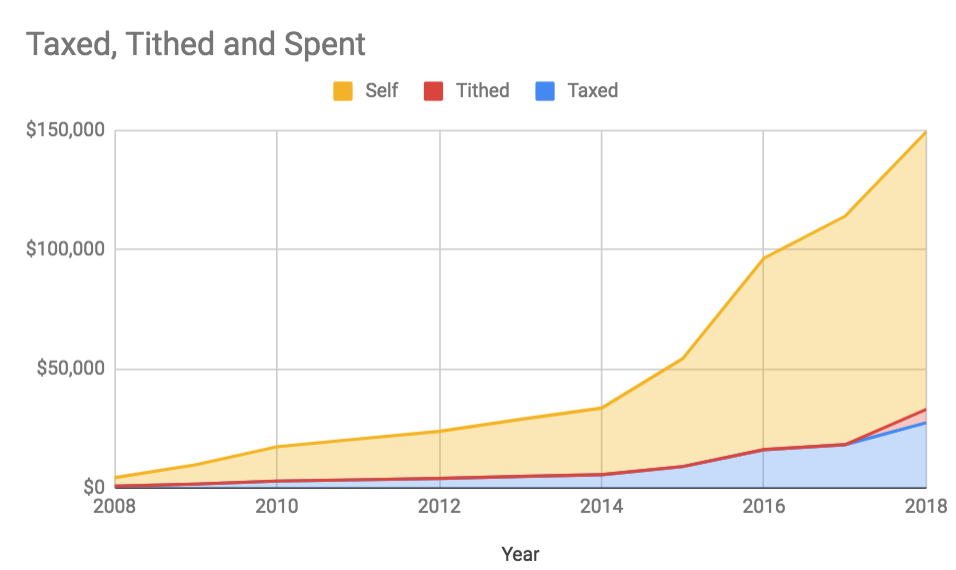
Also, as a note, I’m pretty bullish on radical transparency here (and I’ve already told you how much I make), so here is my bank account:

Let’s dive deeper into my monthly tithe. Of my $880/month, here’s how I broke it up:
- $320/month to Effective Altruism.
- $1/month to Internalize My Negative Externalities
- $50/month to Social Justice
- $40/month to Create Abundance in my Hyper Local Community
- $59/month to Fund Digital Infrastructure/Crypto
- $10/month to the U.S. Government
- $400/month to Spread Universal Tithing
Let’s look at each of them!
$320/month to Effective Altruism
This one is pretty simple. I feel like you should give at least half of your tithe to Effective Altruism (EA) causes.
- I’m giving $120/month to GiveDirectly’s basic income trial. At $30/month per basic income, this supports 4 extremely poor folks in rural Kenya. I find GiveDirectly a no-brainer for folks living in developed countries. Give just $30/month to support someone’s basic income, make them much happier, and lead to positive long-term positive-sum emergent properties from the mechanism described above. (Also I like the feeling of one of their branding headlines—“Give to people, not to charity.”)
- I’m giving $200/month to EA Funds, divided equally among Global Health and Development, Animal Welfare, Long-Term Future, and Effective Altruism Meta. This is an easy way to give the domain experts (the EA fund managers) power to put the money where they see fit.
$1/month to Internalize My Negative Externalities
The macro idea here is highly connected to the system-level view of humans. Namely: we should think of ourselves as nodes on a graph and apply any actions we take to the rest of the graph. This is similar to Kant’s categorical imperative: Act only according to that maxim whereby you can, at the same time, will that it should become a universal law. i.e. Only do something if you think all folks should do it. We can attempt to make all “nodes” internalize (offset) their negative externalities. i.e. We can “close the loop” of our system. Economists call this a Pigovian Tax.
The clearest negative externality that I have is my carbon footprint (though you can see other externalities here). On average, folks produce 10 tonnes of CO2e each year. (Or if you want a more exact number, it’s [5 + # of flights]. For a super exact number, I recommend http://carbotax.org/.) You can pay ~$1 to Coalition for Rainforest Nations (no longer Cool Earth) to offset each tonne of CO2e (see executive summary here). So, per month, I should pay 10 tonnes/year * $1/tonne = $10/year ~= $1/month. In other words, individual carbon neutrality is cheap. Also just FYI, I‘ve donated $240 to Coalition for Rainforest Nations to carbon offset my life thus far. (I’m about to be 28 and had already offset 4 years, so had 24 years left at $10/year = $240.)
One final note: I’ve been a vegetarian for 10 years. I did it to decrease my climate footprint. But it doesn’t really have much of an effect. It’s about 1 tonne of CO2e/year — so just one flight! (Source) However, it makes me sad that so many of my friends are vegetarian for environmental reasons, but they don’t offset their emissions! i.e. Vegetarianism is having a relatively small impact from a climate perspective, but it’s much more socialized than offsetting. (I haven’t stopped being a vegetarian btw. Animal suffering is still bad!)
$50/month to Social Justice
Social Justice is also incredibly important. Who wouldn’t want to (and feel obligated to) dismantle what Bell Hooks calls the “imperialist, white-supremacist, capitalist patriarchy”?
I decided to give $50/month to The National Council for Incarcerated and Formerly Incarcerated Women and Girls, who seeks to end the incarceration of women and girls. They were recommended by the Open Philanthropy Project and OPP estimates that $500 averts 1 year in prison for a person. (So after 10 months, I’ll have done that!) I especially like funding criminal justice reform because it intuitively makes so much sense to have reasonable people contributing to society rather than behind bars. It’s also quite intersectional in helping folks in historically marginalized communities of gender, race, and socioeconomic status.
$60/month to Fund Digital Infrastructure/Crypto
It’s also important to fund public digital infrastructure (because the government primarily funds physical infrastructure, not digital). This is also connected to my work in cryptocurrency. I’ve decided to fund these folks:
- $10/month to Wikipedia. Given how much I/we use them, it’s been a long time coming! (An example of their role in digital infrastructure—they’re used by YouTube as a “source of truth” against conspiracy theories.)
- $5/month to Creative Commons. For fighting against record labels and promoting a non-accumulation/remix mindset around digital creative intellectual property.
- $10/month to Open Collective. For enabling distributed communities to fundraise. (Unfortunately, Open Collective’s Back Your Stack tool is still focused on Javascript, so there weren’t great options to back the Ethereum or Bitcoin repos.)
- $6/month to BitGive. For being the original crypto-enabled charity.
- $5/month to GiveCrypto. For pushing crypto-enabled charity and experimentally tackling crypto adoption.
- $5/month to Bitcoin Venezuela. For feeding Venezuelans and providing them with a monetary store of value. h/t Jill Carlson and Alejandro Machado, here.
- $5/month to Andreas Antonopoulos. For teaching crypto to the masses in an open, selfless way. (While I’m mention funding through Patreon, I also gave $5/month to Nicky Case for creating explorable explanations of systems.)
- $5/month to Ethereum All Core Devs community project management through Gitcoin. I’m especially excited to support this because I was an early adopter of StakeTree (an ETH-based Patreon). I’m excited to see Gitcoin go further with this idea and push subscription standards like EIP-1337 and experiments with Liberal Radicalism.
- $5/month to fund the MakerScan team by helping them pay off their ETH/DAI debt. This one is a bit weird, but I’m super into it, so it’s worth explaining how it works. The team that is building MakerScan has locked ETH to create DAI (a stable coin) in a Collateralized Debt Position (CDP). I can help them pay off their debt by either “wiping DAI” or adding ETH to their CDP here. This means that I can decrease the amount of DAI that they “owe back”, or I can add to the value of their collateral (ETH). h/t Nick Tomaino for finding this.
- I was going to fund Yeastplume’s Grin development, but its already full so I’ll wait until his next round.
$10/month to the U.S. Government
This is a weird one too and is interesting to me for two reasons. First, I think that it re-emphasizes the meta-bucket that both taxes and tithing share, which is “giving to the public good”. Second, I want to embody the mindset of “abundance/enough/non-accumulation”. One way to do that is to say “hey, I’ll give more money to the government than they ask for!” (Or, alternatively, you could not report your charitable deductions.) I honestly believe this is a super powerful mindset. I’d love to be able to give to the government programs that I love. (e.g. I wanted to pay the U.S. Office of Government Ethics.)
Unfortunately, this is pretty difficult. I could pay to reduce the government debt, but that felt too general. Most branches don’t accept donations (the ones on Pay.gov are mostly for other payments). For the ones that accept donations, many didn’t accept digital payment (e.g. the Great Sand Dunes National Park only accepts mailed checks). To be honest, I wasn’t really sure what to do here (I also thought about donating to my local school). In the end, I decided to donate $10/month to the National Park Foundation, which is just a charity that supports the National Parks. Kind of sad given that the whole goal of this category was to give to government not charity, but alas. (Especially happy for feedback on this section! How can I give money to specific departments in the U.S. government?)
$40/month to Create Abundance in my Hyper Local Community
As part of Universal Tithing, I’m a big fan of creating a feeling of abundance within one’s local community. You can imagine something like Effective Altruism as “max impact” and something like this as “max closeness” (your neighborhood). I tried this last time by giving $250 to my old co-op house in Denver (which they spent on the community garden!). This time, I’m giving to two things:
- Donating $20/month to my local community organization, Allston Brighton Community Development Corporation (ABCDC). There are often two options when you’re trying to give locally. Either something super YIMBY-y like ABCDC or something super NIMBY-y like SaveBrighton. Give to the YIMBY!
- Donating $20/month to a random stranger on NextDoor. This one is a bit weird. You can imagine it kind of like a crypto faucet, but for USD in your community. (Similar to Nadia Eghbal’s idea of “Patron not Patreon”.) You can also relate it to GiveDirectly (peer-to-peer money transfer, but local instead of global). But unlike GiveDirectly, this funding is more likely to loop ROI back to me (in the Egoistic Altruism sense) by strengthening my community (which I will then be impacted by).
So to do this, I offered “Free $120” on NextDoor, I (surprisingly) got only 1 response! (It’s free money people!) Here is the response I got:
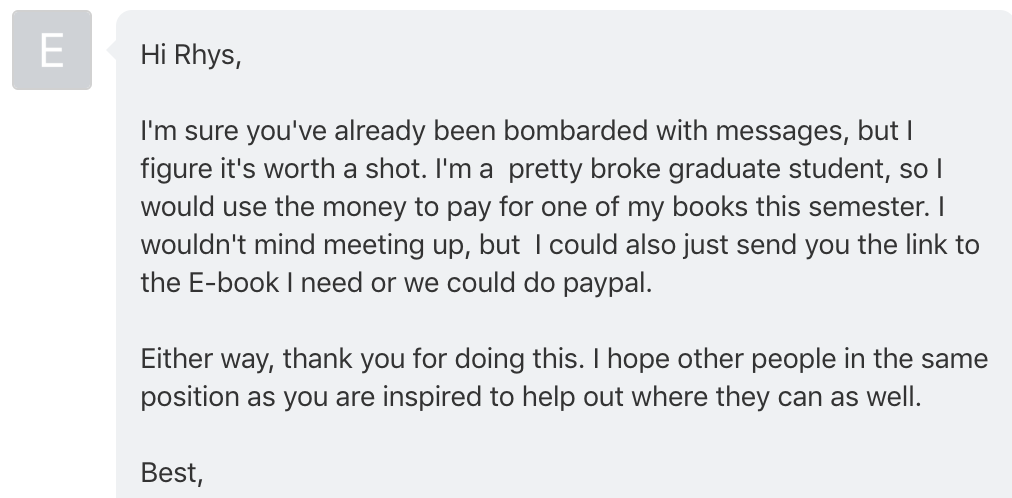
I responded that I was going to give him the money. He responded:
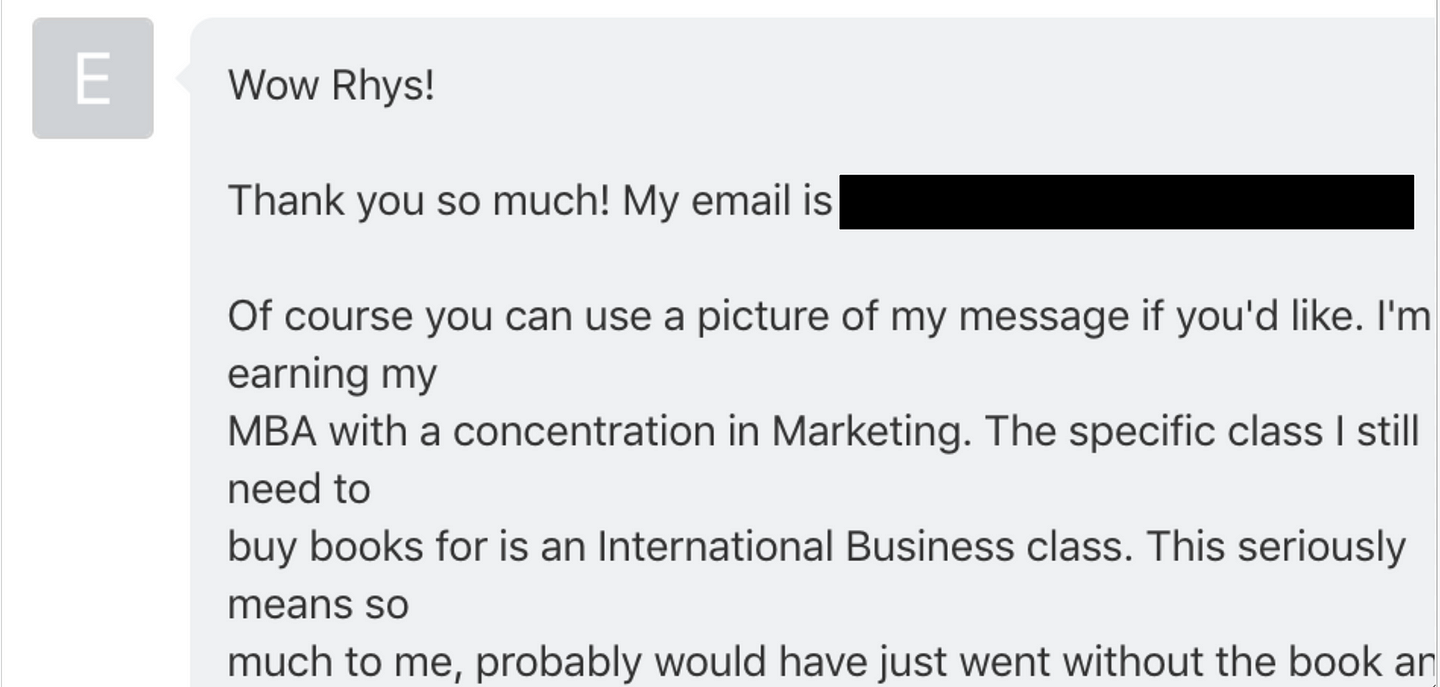
So I just PayPal’ed him the money! I’m not sure if this NextDoor thing is the best way to go about this, but I really like the concept of freely giving to folks in your community. (Here’s another example of this!)
$400/month to Spread Universal Tithing
I’m also “setting aside” $400/month for experiments that are designed to spread the idea of Universal Tithing.
I’m not sure the best way to spread this tithing mindset. There are the general pledges like Giving What We Can and there are the identity-based pledges like Founders Pledge. I’m relatively bullish on the identity-based pledges, but not sure which ones to start with. I like the idea of something like “Carbon Neutral Climate Scientists.” (Seriously, why doesn’t this exist? Climate scientists should actively act on their research conclusions [by becoming carbon neutral] in addition to furthering research.) I’m also exploring a variety of place-based tithing groups, like MIT Community Giving.
Also, I’m increasingly interested in being the “matching side” for various matching donation schemes (i.e. we should crowdfund the “matching side” in addition to the giving side). As I was thinking about how to do this, the #GitcoinTorch initiative popped up! The idea is this—community members give to a “matching treasury” that is used to fund the next round of CLR matching funds. This is essentially exactly what I was looking for, so I just sent $5/month for next 6 months. (Etherscan link.) (Although this doesn’t directly spread the idea of Universal Tithing, it is one of the 1st implementations of a crowdfunded matching treasury, which is exactly what I think should exist.)
Finally, as a part of this bucket, I’ve given my $400 to support the RadicalXChange event (Detroit March 22–24!). They’re highly aligned with the vision outlined here (experimenting with a variety of matching mechanisms, e.g. Liberal Radicalism, in order to fund a new 3rd sector of civil society.)
To conclude: I hope I’ve shown:
- Why Universal Tithing is a necessary component of our long-term future (because it enables humanity to be aligned around our long-term future).
- How I am personally trying to manifest the concept of Universal Tithing (through a 20% self-tax).
Finally, if you’d like to dive into some possible extensions to Universal Tithing, check out my additional notes here.
Thanks for reading! If you have any feedback, please reach out to me on Twitter (RhysLindmark) or email me (rhyslindmark@gmail.com). Thanks again!
Thanks to Neha Narula for her feedback on my 1st draft and to the rest of the DCI team for their constructive comments on an initial presentation of these ideas.
If you want to read more about personal giving, I liked these recent 2019 recaps:
- Nadia Eghbal on giving personal grants
- Haseeb Qureshi on transparency and giving to EA meta-funds
- Larks on where to give in AI alignment
- Jeff and Julia on tracking your donations and how it feels to tithe 50%
Disclaimers: This interview is not investment advice. The views and opinions expressed in this article are my own and do not reflect my employer :). I own less than $5000 of any given cryptocurrency, so my monetary incentive is not too aligned with Bitcoin, Ethereum, etc.